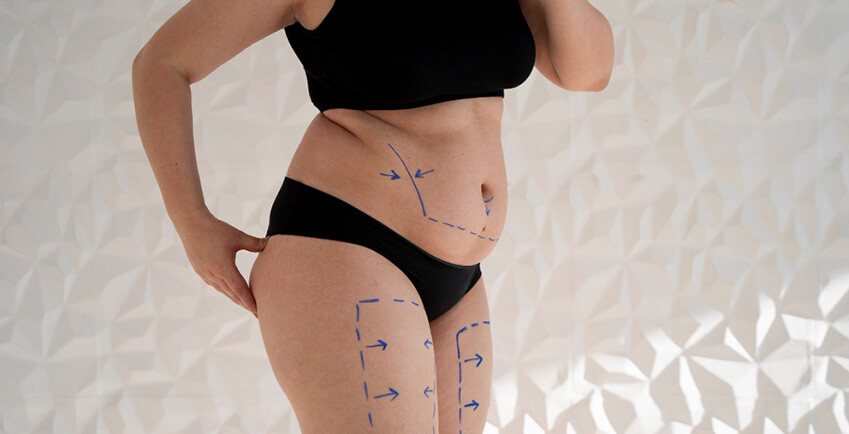The world of social media has now given the access to lots of information and also it has made the public aware about their body. More and more image conscious people are opting Plastic Surgery to feel more confident in their body. Among these procedures, liposuction remains one of the most popular choices. But with rising popularity also comes rising concern: How safe is liposuction? What are the real liposuction risks, and what should you know before choosing surgical fat removal?
Let’s know the truth behind liposuction safety, the myths and understand how you can safely achieve the body contour that you have always desired.
What is Liposuction?
Liposuction is a cosmetic surgery that removes stubborn fat deposits from specific areas of the body such as the abdomen, thighs, arms, back, neck, and chin. It is not a weight loss surgery but we can say it as an inch-loss surgical method. It is a body-contouring tool for people who are already close to their ideal body weight but struggle with localized fat pockets that don’t respond to diet or exercise.
Understanding Liposuction Safety
Like any surgical procedure, liposuction comes with risks. However, when performed by a qualified, board-certified plastic surgeon in a safe, accredited setting, liposuction is generally considered very safe.
Cosmetic surgery safety is not just about the surgery itself—it involves patient selection, surgical technique, anaesthesia safety, postoperative care, and the facility where the procedure is performed.
Key factors that enhance liposuction safety:
- Proper Patient Selection – Ideal candidates are healthy, non-smokers with realistic expectations.
- Trained Surgeons – A board-certified plastic surgeon with experience in body contouring procedures significantly reduces liposuction risks.
- Safe Anaesthesia–It involves use of infiltration of tumescent fluid to administration of anaesthetic drugs. Trained anaesthetist plays major role in monitoring throughout the surgery ensuring enhanced safety.
- Accredited Facilities – Operating in certified hospitals or surgical centers with emergency support systems.
- Limited Volume Fat Removal – Adhering to guidelines that limit the amount of fat removed in a single session (usually under 5 liters) reduces complications.
- Postoperative Monitoring – Good follow-up care ensures early detection and management of complications.
Risks of Liposuction: What You Should Know
Despite its safety record, it’s important to be aware of the potential risks of liposuction. These may include:
- Infection – Rare but serious if not promptly treated.
- Bleeding or Hematoma – Collection of blood under the skin that may need drainage.
- Seroma – Fluid accumulation requiring needle aspiration.
- Contour Irregularities – Uneven fat removal can cause dimpling or asymmetry.
- Skin Laxity – Loose skin may be left behind if elasticity is poor.
- Anaesthesia Risks – As with any surgery, general anaesthesia carries its own risks.
- Fat Embolism – A rare but potentially fatal complication if fat enters the bloodstream.
Understanding these liposuction complications doesn’t mean you should fear the procedure—it means you should prepare, ask questions, and choose your surgeon wisely.
How to Minimize Liposuction Risks?
Here are a few simple steps patients can take to reduce liposuction risks:
- Consult a Certified Plastic Surgeon – Always check your surgeon’s credentials.
- Be Honest About Your Health – Full medical disclosure allows better planning and safety.
- Avoid Smoking and Alcohol – These impair healing and increase surgical risks.
- Follow Pre- and Post-op Instructions – Compliance is key to recovery and results.
- Do Not Seek Extreme Transformations – Liposuction is not a substitute for a healthy lifestyle.
Advances in Liposuction Technology and Techniques
The field of surgical fat removal has come a long way. Modern liposuction techniques are more precise and gentle, with less downtime and better results.
Types of Liposuction:
- Tumescent Liposuction – A standard method where fluid is injected before fat removal to reduce pain and bleeding.
- Power-Assisted Liposuction (PAL) – Uses a vibrating cannula to break up fat more efficiently.
- Laser-Assisted Liposuction – Uses laser energy to liquefy fat and promote skin tightening.
- Ultrasound-Assisted Liposuction (UAL) – Breaks fat cells with ultrasonic waves, especially useful in fibrous areas like the back or male chest.
These advancements have significantly improved liposuction safety and results. However, technology alone cannot replace the importance of an experienced surgeon.
Liposuction vs. Non-Surgical Fat Removal
In recent years, non-surgical body contouring procedures like CoolSculpting, Ultrasound lipolysis, injections (like Kybella) and Radiofrequency treatments have become popular. These are appealing due to their non-invasive nature, but they often require multiple sessions, come with a hefty price and provide limited results compared to surgical fat removal.
While these alternatives have their place, especially for small fat pockets, liposuction remains the gold standard for dramatic and long-lasting results when performed safely.
The Final Word: Is Liposuction Safe?
Yes—liposuction is safe when performed on the right patient, in the right setting, by the right surgeon. Just like flying an airplane, it’s not the act itself that’s risky—it’s who is in charge and how well the process is managed.
To ensure a safe and satisfying experience, take the time to:
- Educate yourself
- Choose your surgeon carefully
- Maintain realistic expectations
- Follow all safety protocols
Remember, cosmetic surgery safety is a shared responsibility between the patient and the medical team. Together, we can make your transformation journey a safe and beautiful one.
Author: Dr Aravind Hosamani
Phone: +91 8050429249
IAAPS No: 2023/KA/80
Email: aravind.hosamani@gmail.com
Disclaimer : The opinions here are personal views of the authors. IAAPS is not responsible. All members may not have the same scientific view point

